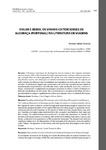Mostrar o rexistro simple do ítem
Viajar e beber. Os vinhos cistercienses de Alcobaça (Portugal) na literatura de viagens
| dc.contributor.author | Maduro, António Valério | es_ES |
| dc.date.accessioned | 2014-04-30T11:01:07Z | |
| dc.date.available | 2014-04-30T11:01:07Z | |
| dc.date.issued | 2012 | es_ES |
| dc.identifier.citation | ROTUR: Revista de ocio y turismo, 2012, 5: 149-160. ISSN: 1888-6884 | es_ES |
| dc.identifier.issn | 1888-6884 | es_ES |
| dc.identifier.uri | http://hdl.handle.net/2183/12146 | |
| dc.description.abstract | [Resumo] O Mosteiro cisterciense de Alcobaça foi alvo do interesse dos viajantes ilustrados que nos séculos XVIII e XIX visitaram Portugal e permaneceram o tempo suficiente para alargar o périplo além da cintura geográfica da capital. Com esta visita procuravam apreciar a arquitectura e a arte, com relevo para os túmulos historiados de Pedro e Inês. Os viajantes de maior estatuto beneficiaram das comodidades da hospedaria monástica, da sua mesa e seus néctares. A literatura de viagens que produziram é de particular importância para avaliar as transformações arquitectónicas do edificado, sentir a vida da Abadia, seus usos, costumes e rituais, compreender a organização da paisagem produtiva. A vinha e o vinho constituem referências significativas nas descrições. São as vinhas da cerca monástica e do relego da Gafa, a grandiosidade da adega e a qualidade dos vinhos que reputam como os melhores da Europa. | es_ES |
| dc.description.abstract | [Abstract] The Cistercian Monastery of Alcobaça was the target of interest to scholarly travelers that in the eighteenth and nineteenth visited Portugal and stayed long enough to extend the tour beyond the geographical belt of the capital. With this visit, they sought to appreciate the architecture and art, with emphasis on the tombs of Pedro and Inês, whose history was written. Travellers of a higher status benefited from the monastic hostel facilities, their table and their nectars. The travel literature they produced is of particular importance to evaluate the architectural transformations of buildings, feel the life of the Abbey, their habits, customs and rituals, understand the organization of the productive landscape. The vineyard and wine are significant references in the descriptions. It’s the vineyards of the monastic enclosure and the Gafa’s “relego”, the grandeur of the winery and wine quality that they regard as the best in Europe. | es_ES |
| dc.description.abstract | [Resumen] El monasterio cisterciense de Alcobaça fue objeto de interés para los viajeros ilustrados que visitaron Portugal en los siglos XVIII y XIX y permanecieron el tiempo suficiente para alargar su periplo más allá del cinturón geográfico de la capital. Con esta visita buscaban apreciar la arquitectura y el arte, en especial los túmulos historiados de Pedro e Inés. Los viajeros de mayor estatus se beneficiaban de las ventajas de la hospedería monástica, de su mesa y sus néctares. La literatura de viajes que produjeron es de particular importancia para evaluar las transformaciones arquitectónicas de los edificios, sentir la vida de la abadía, sus usos, costumbres y rituales, y comprender la organización del paisaje productivo. Los viñedos y el vino constituyen referencias significativas en las descripciones. Son los viñedos cercanos al monasterio y del “lagar de la Gafa”, la grandiosidad de la bodega y la calidad de los vinos que reputan como los mejores de Europa. | es_ES |
| dc.language.iso | por | es_ES |
| dc.publisher | Universidade da coruña | es_ES |
| dc.subject | Alcobaça | es_ES |
| dc.subject | Cister | es_ES |
| dc.subject | Viagens | es_ES |
| dc.subject | Vinhas | es_ES |
| dc.subject | Vinhos | es_ES |
| dc.subject | Cistercian | es_ES |
| dc.subject | Travel | es_ES |
| dc.subject | Vineyards | es_ES |
| dc.subject | Wine | es_ES |
| dc.title | Viajar e beber. Os vinhos cistercienses de Alcobaça (Portugal) na literatura de viagens | es_ES |
| dc.title.alternative | Travelling and drinking. The cistercian wines of Alcobaça (Portugal) in travel literature | es_ES |
| dc.type | info:eu-repo/semantics/article | es_ES |
| dc.rights.access | info:eu-repo/semantics/openAccess | es_ES |






